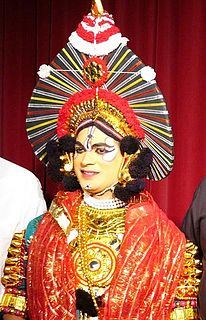 W
WThe southern state of Karnataka, in India, has a distinct art and culture informed by a long history of diverse linguistic and religious ethnicity. Apart from Kannadigas, Karnataka is home to Tuluvas, who also consider themselves as Kannadigas. Minor populations of Tibetan Buddhists and Siddhi tribes plus a few other ethnic groups also live in. The traditional folk arts are major theatrical forms of coastal Karnataka. Contemporary theatre culture in Karnataka is one of the most vibrant in India with organizations like Ninasam, Ranga Shankara and Rang on foundations laid down by the Gubbi Veeranna Nataka Company. Veeragase, Kamsale and Dollu Kunitha are popular dance forms. Bharatanatya also enjoys wide patronage in Karnataka.
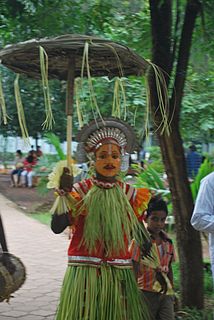 W
WAati Kalenja is an ancient traditional folk art form practiced by Tulu people from the region of Tulu Nadu, India which is believed to bring prosperity during Aati which is one of the months in Tulu calendar. It normally comes in the months of July and August.
 W
WThe antiquity of architecture of Karnataka can be traced to its southern Neolithic and early Iron Age, Having witnessed the architectural ideological and utilitarian transformation from shelter- ritual- religion. Here the nomenclature 'Architecture' is as old as c.2000 B.C.E. The upper or late Neolithic people in order to make their shelters, they constructed huts made of wattle and doab, that were buttressed by stone boulders, presumably having conical roof resting on the bamboo or wooden posts into red murram or paved granite chips as revealed in archaeological excavations in sites like Brhamagiri, Sanganakallu, Tekkalakota, Piklihal. Megaliths are the dominant archaeological evidence of the early Iron Age. There are more than 2000 early Iron Age burial sites on record, who laid the foundation for a high non-perishable architecture in the form of various distinct architectural styles of stone built burials, which are ritualistic in its character. The active religious architecture is evident 345 with that of the Kadamba Dynasty. Karnataka is a state in the southern part of India originally known as the State of Mysore. Over the centuries, architectural monuments within the region displayed a diversity of influences, often relaying much about the artistic trends of the rulers of twelve different dynasties. Its architecture ranges dramatically from majestic monolith, such as the Gomateshwara, to Hindu and Jain places of worship, ruins of ancient cities, mausoleums and palaces of different architectural hue. Mysore Kingdom (Wodeyar) rule has also given an architectural master structure in the St. Philomena's Church at Mysore which was completed in 1956, in addition to many Dravidian style architectural temples. Two of the monuments are listed under the UNESCO World Heritage List of 22 cultural monuments in India. Styles of Indo-Saracenic, Renaissance, Corinthian, Hindu, Indo-Greek and Indo-British style palaces were built in Mysore, the city of palaces. Sikh architecture at Bidar (1512) and also in Bangalore in 1956 can also be cited as having an impact on the architectural composition of the state.
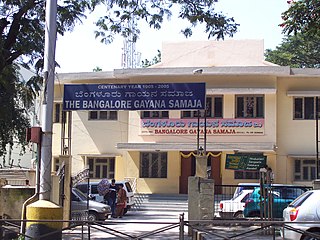 W
WBangalore Gayana Samaja is one of the oldest cultural organisations in Bangalore and was established in 1905. It is the oldest operational sabhā in India. The organisation focuses on various Indian forms of Indian music such as Carnatic music, Hindustani music, devotional, light music, Harikathe, folk music and theatre along with various Indian dance forms such as Bharatanatya, Kuchipudi, Kathak, Kathakali, Chau, Odissi and Manipuri.
 W
WBidriware is a metal handicraft from Bidar. It was developed in the 14th century C.E. during the rule of the Bahamani Sultans. The term "bidriware" originates from the township of Bidar, which is still the chief centre for the manufacture of the unique metalware. Due to its striking inlay artwork, bidriware is an important export handicraft of India and is prized as a symbol of wealth. The metal used is a blackened alloy of zinc and copper inlaid with thin sheets of pure silver. This native art form has obtained Geographical Indications (GI) registry.
 W
WChannapatna toys are a particular form of wooden toys and dolls that are manufactured in the town of Channapatna in the Ramanagara district of Karnataka state, India. This traditional craft is protected as a geographical indication (GI) under the World Trade Organization, administered by the Government of Karnataka. As a result of the popularity of these toys, Channapatna is known as Gombegala Ooru (toy-town) of Karnataka. Traditionally, the work involved lacquering the wood of the Wrightia tinctoria tree, colloquially called Aale mara (ivory-wood).
 W
WKarnataka has a variety of traditional arts, including folk dance and puppetry.
 W
WHalasi is a town in Khanapur Taluk, Belgaum District in Karnataka, India. It is 14 km from Khanapur and about 25 km from Kittur. As known from inscriptions, the ancient name of the town was Palāśikā. A centre of the early Kadamba Dynasty, it was a minor capital of the Goa Kadambas (980-1025). The town is notable for a series of medieval temples. The most famous are the Varāha Narasiṃha temple and Suvarṇeśvara temple in the town, and a third temple of Rāmeśvara. On a hill about 1.9 km. south-west of the town is a pilgrimage place known as Rāmatītha. There is also a Jain temple in Halasi as well as mosques and tombs, most notably the Dargah of Hazrat Nūr al-Dīn Shāh Qadri. The Eidgah is located south of the town.
 W
WHarikatha, also known as Harikatha Kaalakshepam in Telugu and Tamil, is a form of Hindu traditional discourse in which the storyteller explores a traditional theme, usually the life of a saint or a story from an Indian epic. The person telling the story through songs, music and narration is called a Haridasa.
 W
WIlkal sari is a traditional form of sari which is a common feminine wear in India. Ilkal sari takes its name from the town of Ilkal in the Bagalkot district of Karnataka state, India. Ilkal saris are woven using cotton warp on the body and art silk warp for border and art silk warp for pallu portion of the sari. In some cases instead of art silk, pure silk is also used. Ilkal sari has been accorded geographical indication (GI) tag. Its GI tag number is 76.
 W
WJaya Bharata Jananiya Tanujate is a Kannada poem, which was composed by the Indian national poet Kuvempu. The poem was officially declared the state song of the Indian state of Karnataka on 6 January 2004.
 W
WKadamba architecture was a style of temple architecture founded by Mayurasharma in the 4th century AD in Karnataka, India. Kadambas created new style of architecture which was the basis of the Hoysalas style of architecture, developed original school of sculpture, was the forerunner of series of South Indian sculptors. Many temples at Aihole, Badami and Hampi are built in Kadamba style.
 W
WKangeelu or Kangilu is a traditional folk dance of particular significance to the Udupi and Karnataka communities of India. It is a spiritual form of dance performed by the Mandal community. Kangilu is performed only on the day of a full moon, and it is believed to keep away disease, evil spirits, and other negative energy, and to foster peace, harmony, and a community spirit. Kangeelu is not purely dancing, but a dance act. There are 5–12 members in the group wearing the same costumes and makeup.
 W
WKannada Saahithya Parishath is an Indian non-profit organisation that promotes the Kannada language and its literature. Its headquarter is in the city of Bengaluru in the state of Karnataka, India. It strives to promote Kannada language through publishing books, organising literary seminars and promoting research projects. It also organises an annual conference on Kannada literature called Kannada Sahithya Sammelana. The current president of the parishat is Manu Baligar.
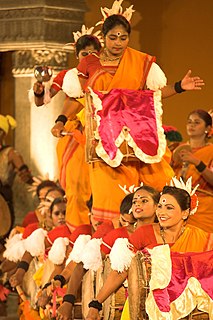 W
WKannada Rajyotsava, also known as Karnataka Formation Day or Karnataka Day, is celebrated on 1 November of every year. This was the day in 1956 when all the Kannada language-speaking regions of south western India were merged to form the state of Karnataka.
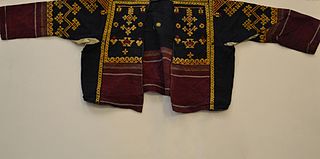 W
WKasuti is a traditional form of folk embroidery practised in the state of Karnataka, India. Kasuti work which is very intricate sometimes involves putting up to 5,000 stitches by hand and is traditionally made on dresswear like Ilkal sarees, Ravike and Angi or Kurta. The Karnataka Handicrafts Development Corporation (KHDC) holds a geographical indications (GI) protection for Kasuti embroidery which provides intellectual property rights on Kasuti to KHDC.
 W
WA katcheri is an assembly of musicians and audience in the context of Carnatic music or Karnatick music. It is presented in the concert format. The music fraternity of connoisseurs and common people assemble at the katcheri venues to listen to classical music concerts of vidwans. Etymologically the word "katcheri" is derived from Urdu language and in Hindi to mean a court of law.
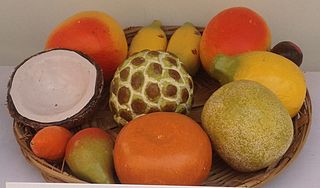 W
WKinnal Craft or Kinhal Craft, is a traditional wooden craft local to the town of Kinhal, or Kinnal, in Koppal District, North Karnataka, India.
 W
WMachideva Jayanthi is traditionally observed by the Madivalas and is observed as a celebrate in the Indian state of Karnataka. It marks the birthday of Madivala Machideva, 12th-century Warrior-Saint, and the founding saint of the Madivala religion. The festival is celebrated with much pomp and gaiety all over south India, majorly in Karnataka, Maharashtra, Andhra Pradesh and Tamil Nadu.
 W
WThe Mahabaleshwar Temple, Gokarna is a 4th-century CE Hindu temple located in Gokarna, Uttara Kannada district, Karnataka state, India which is built in the classical Dravidian architectural style. It is a site of religious pilgrimage. The temple faces the Gokarna beach on the Arabian Sea in which Hindu pilgrims cleanse before visiting the temple for worship. The temple deifies the Pranalinga also called Atmalinga or Shiva Linga In legend, it is said that the deity of the temple will bestow immense blessings to devotees, even to those who only glimpse it. Currently the administrative charge of the temple is with an Overseeing Committee under the Chairmanship of Justice BN Srikrishna, a Retired Justice of the Hon'ble Supreme Court of India.
 W
WThe mundu is a garment worn around the waist in the Indian states of Kerala, Tamil Nadu, Andhra Pradesh, the Lakshadweep archipelago, and the Indian Ocean island nation of Maldives. It is closely related to sarongs like dhotis and lungis. It is normally woven in cotton and coloured white or cream. The colour is dependent on whether the cotton is bleached or unbleached. A khaddar mundu is made using handlooms. When unbleached, the mundu is called "neriyathu". In modern times, two types of mundu are prevalent—the single and the double. A single mundu is wrapped only once around the waist, while the double one is folded in half before wearing. A mundu is usually starched before use.
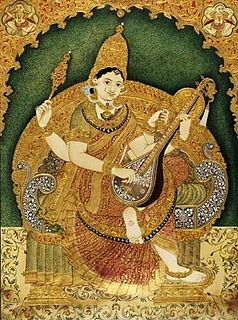 W
WMysore painting is an important form of classical South Indian painting that originated in and around the town of Mysore in Karnataka encouraged and nurtured by the Mysore rulers. Painting in Karnataka has a long and illustrious history, tracing its origins back to the Ajanta times The distinct school of Mysore painting evolved from the paintings of Vijayanagar times during the reign of the Vijayanagar Kings The rulers of Vijayanagar and their feudatories encouraged literature, art, architecture, religious and philosophical discussions. With the fall of the Vijayanagar empire after the Battle of Talikota the artists who were till then under royal patronage migrated to various other places like Mysore, Tanjore, Surpur, etc. Absorbing the local artistic traditions and customs, the erstwhile Vijayanagar School of Painting gradually evolved into the many styles of painting in South India, including the Mysore and Tanjore schools of painting.
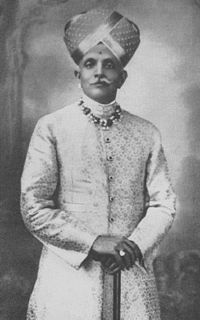 W
WThe Mysuru peta is the classical royal Indian attire worn by the erstwhile Kings of Mysuru, called the Wodeyars, of the Kingdom of Mysuru. Wodeyars wore a richly bejeweled turban made of silk and jari to match with colorful dresses as part of the royal dress.
 W
WMysore Sandalwood Oil is a trademarked perfume oil extracted from the Santalum album variety of sandalwood tree in the Mysore district of Karnataka, India. The tree species is said to be one of the best varieties in the world.
 W
WNagaradhane is a form of cobra worship which, along with Bhuta Kola, is one of the unique traditions prevalent in coastal districts of Dakshina Kannada, Udupi and Kasaragod alternatively known as Tulu Nadu, practiced by Tuluva community members. Cobras are not just seen as deities, but as an animal species which should be respected, appeased and protected for multiple social, religious and ecological reasons.
 W
WNeer dosa, literally meaning water dosa in Tulu, is a crêpe prepared from rice batter. Neer dosa is a delicacy from Tulu Nadu region, and part of Udupi - Mangalorean cuisine.
 W
WNinasam is a cultural organisation located in the village of Heggodu in Sagar Taluk of the Shivamogga district in the state of Karnataka, India. Ninasam is the short form of Sri NIlakanteshwara NAtyaseva SANgha, an organisation dedicated to the growth of drama, films and publishing. Akshara, the current head of Ninasam, tells a story where Ni means you, Na means me, and Sam is a pun on the English word Sum, and in music is the moment where rhythm comes together. Ninasam was the brainchild of the renowned dramatist and Magsaysay award winner, K V Subbanna. As he said, it is the communitarian activity. Ninasam works similarly to a co-operative society. Currently A R Shreedhara Bhatt, a retired revenue officer, is the president, and K V Akshara, the son of Subbanna, is the director.
 W
WUttara Karnataka, is a geographical region in Deccan plateau from 300 to 730 metres elevation that constitutes the region of the Karnataka state in India and the region consists of 14 districts. It is drained by the Krishna River and its tributaries the Bhima, Ghataprabha, Malaprabha, and Tungabhadra. North Karnataka lies within the Deccan thorn scrub forests ecoregion, which extends north into eastern Maharashtra. Most parts of the region has black fertile soil ideal for agriculture.
 W
WRangayana is a theatre institute which operates from Mysore, Karnataka, India. It works as an autonomous cultural institute. The organization consists of a professional repertory company, a theatre-training institute and a documentation and research centre. Rangayana offers courses in stage craft, preparation and presentation of plays in Kannada. It also conducts programs for promotion of Kannada theatre. Rangayana hosts a theatre festival in Mysore every year. Rangayana is the only government sponsored repertory in the country. It is also undertaking a project to introduce theatre to kids and has created a children's repertory in association with the International Theatre Institute and Swedish International Development Cooperation Agency.
 W
WSaundatti also known as Savadatti is one of the oldest towns in Belgaum district in the Indian state of Karnataka. It is a celebrated pilgrimage centre located 78 kilometres from Belgaum and 37 kilometres from Dharwad. Savadatti is also the name of the taluk (sub-district), which was previously named Parasgad. There are several ancient temples in Saundatti.
 W
WSeven stones is a game from the Indian subcontinent involving a ball and a pile of flat stones, generally played between two teams in a large outdoor area. It is played today in villages.
 W
WSharabha or Sarabha is a part-lion and part-bird beast in Hindu mythology, who, according to Sanskrit literature, is eight-legged and more powerful than a lion or an elephant, possessing the ability to clear a valley in one jump. In later literature, Sharabha is described as an eight-legged deer.
 W
WTogalu gombeyaata is a puppet show unique to the state of Karnataka, India. Togalu gombeyaata translates to "a play of leather dolls" in the native language of Kannada. It is a form of shadow puppetry. Karnataka Chitrakala Parishat has undertaken research on this art and has a good collection of leather puppets.
 W
WUgadi or Yugadi, also known as Samvatsarādi, is the New Year's Day for the states of Andhra Pradesh, Telangana, and Karnataka in India. It is festively observed in these regions on the first day of the Hindu lunisolar calendar month of Chaitra. This typically falls in April month of the Gregorian calendar.